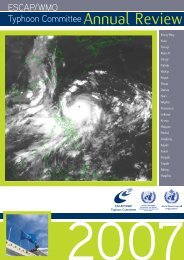TCAR - Typhoon Committee
TCAR - Typhoon Committee
TCAR - Typhoon Committee
Create successful ePaper yourself
Turn your PDF publications into a flip-book with our unique Google optimized e-Paper software.
JAPAN<br />
1. Progress on Key Result Area 1: Reduced Loss<br />
of Life from <strong>Typhoon</strong>-related Disasters.<br />
a. Meteorological Achievements/Results<br />
b. Hydrological Achievements/Results<br />
c. Disaster Prevention and Preparedness<br />
Achievements/Results<br />
c-1. Major Disaster and Response Measures since<br />
January 2009<br />
In 2009, Japan suffered from a number of bouts of<br />
torrential rain. In particular, heavy rain from<br />
19 to 21 July 2009 caused 31 deaths, and resulted<br />
in 2,191 houses with inundation above floor level.<br />
<strong>Typhoon</strong> No.9 (ETAU) also caused 25 deaths, and<br />
resulted in 962 houses with inundation above floor<br />
level. The national government’s response included<br />
early warning reports from the Japan Meteorology<br />
Agency (JMA), inter-ministerial meetings for<br />
response coordination, and same-day dispatching of<br />
governmental on-site damage survey teams, headed<br />
by the Minister of State for Disaster Management.<br />
c-2. Technical Investigation on Large-Scale Flood<br />
Countermeasures<br />
There has been a large reduction in the total area<br />
inundated by flood disasters thanks to<br />
weather forecasting system improvement and the<br />
promotion of land conservation and flood control<br />
projects over many years. However, in terms of<br />
general assets, the amount of damage in flooded<br />
areas has greatly increased in recent years (Figure 3).<br />
Additionally, the frequency of downpours depositing<br />
more than 100 mm of rain per hour has seen an<br />
increasing trend throughout the country over the last<br />
30 years (Figures 4, 5).<br />
This increasing trend necessitates the strengthening<br />
of countermeasures for quick and smooth<br />
evacuation and relief activities in the event of largescale<br />
flooding. The Central Disaster Management<br />
Council is working on analysis of anticipated situations<br />
and reviewing measures against large-scale flood<br />
disasters that are expected to cause immense damage<br />
to the capital region.<br />
The Central Disaster Management Council, chaired by<br />
the Prime Minister and manned by<br />
other Ministers of State, focuses on the promotion<br />
of comprehensive disaster countermeasures. The<br />
<strong>TCAR</strong><br />
CHAPTER 1 - TYPHOON COMMITTEE ACTIVITIES<br />
Cabinet Office of the Japanese Government initiated an<br />
expert study for analysis of possible large-scale flood<br />
damage in Japan. The trigger for this investigation<br />
was Hurricane Katrina, which caused devastating<br />
damage in the U.S. in August 2005. Another reason<br />
was the fact that there have been no incidents of such<br />
devastating typhoons or floods in Japan for as long as<br />
50 years (since <strong>Typhoon</strong> Ise-wan in 1959), meaning<br />
that the majority of the population is unaware of the<br />
possibility of such a catastrophe.<br />
The study was started in 2006 and is still under way,<br />
but some interesting analysis has already<br />
been conducted. One such example is the simulation<br />
of a potential flood area in the Tone River basin (the<br />
largest river basin in Tokyo). A map of the flood area<br />
was simulated, assuming river dike bleach caused<br />
by hypothetical deadly rainfall with a once-in-200year<br />
likelihood. In the worst-case scenario, more than<br />
two million people could be affected by the flood, and<br />
nearly a million houses could be damaged. Although<br />
this is only a simulation, it is important that the potential<br />
magnitude of related damage is properly understood<br />
by the government and residents alike. (Figure 6)<br />
amount of damage<br />
(billion yen)<br />
(times/year)<br />
10<br />
5<br />
0<br />
1977<br />
400<br />
300<br />
200<br />
100<br />
0<br />
amount of damage amount of damage per flooded area<br />
1986〜’901991〜’951996〜’002001〜’05<br />
Figure 3 Amount of damage to general assets in flooded areas<br />
1977〜1986<br />
average:2.2times<br />
’80<br />
1987〜1996<br />
average:2.4times<br />
’85<br />
’90 ’95<br />
Figure 4 Tendency of downpours (over 100 mm/hr)<br />
60<br />
50<br />
40<br />
30<br />
20<br />
10<br />
0<br />
amount of damage per flooded area<br />
(million yen<br />
100 mm/hr<br />
1997〜2006<br />
average:5. 1times<br />
2000<br />
’05<br />
2009<br />
47

















